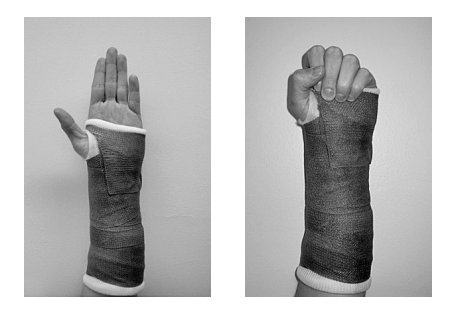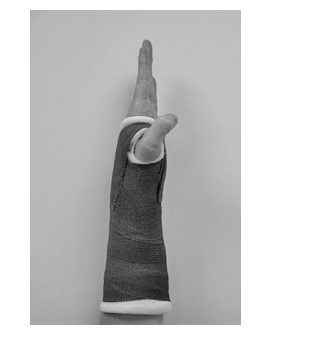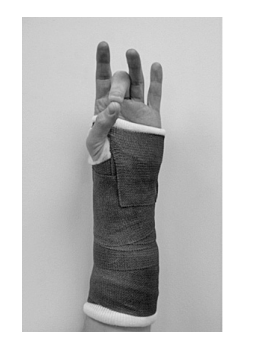While your wrist is in the Back Slab
The type of cast used in the Minor Injury Unit is a back slab. This type of cast only has plaster on one side of the limb, with other bandages wrapped round. Issues with back slabs can be addressed in the Minor Injury Unit. Problems with full casts need to be seen in Accident and Emergency.
- Keep the injured arm raised up with your hand above your elbow as much as possible, especially for the first week.
- Avoid standing or sitting with your hand down by your side. If you can, you should place the affected hand on the opposite shoulder whenever you are standing. When sitting you can place your arm on several pillows. At night, you can rest the arm on two pillows to keep it elevated. This helps to reduce swelling in the arm and prevent the plaster from becoming too tight.
- Move the unaffected joints. You should be able to move your fingers fully when in the plaster cast.
- Perform the exercises below four times a day.
- Use your affected hand for light activities only.
- Do not wear any rings at any time until fully recovered.
Please return to Accident and Emergency (A&E) or the Minor Injury Unit immediately if you are affected by any of the following:
- Increased pain.
- Increased swelling.
- Increased numbness or pins and needles in the affected arm.
- Inability to move your fingers.
- Blueness of the fingers.
- If the plaster cracks, becomes loose or is rubbing your skin.
Do not:
- Do not rest on the plaster or put anything heavy on the plaster for the first 48 hours, to ensure the plaster has fully dried. Once the plaster has fully dried you should still avoid
putting anything heavy on it. - Do not cut your plaster – always attend A&E if your plaster needs trimming.
- Do not wet the plaster. Cover the plaster with a plastic bag or cover when in the bath or shower.
- Do not poke anything down the plaster as you may cut your skin or cause a wound to become infected.
Hand and arm exercises for fractured wrists
It is important to do these exercises for several reasons:
- To keep your joints as mobile as possible, that is, shoulder, elbow and fingers.
- To maintain some strength of the muscles in your arm and hand.
- To minimise painful swelling by improving the circulation.
Try to do these exercises four times each day.
Shoulder flexion
Standing or sitting in an upright position, slowly lift your affected arm up towards the
ceiling (elbow straight) and then lower again. Repeat 5 times.
Elbow flexion and extension
Sitting in an upright position, slowly bend your affected elbow so your hand moves
towards your shoulder and then fully straighten your elbow. Repeat 5 times.
Finger flexion and extension
Place the elbow of your affected arm on the table with your fingers pointing towards
the ceiling. Start with all your fingers straight and then bend all your fingers to make a fist. Repeat 5 times.

Start with all your fingers straight and then bend the knuckle joints of all your fingers, keeping the fingers straight. Repeat 5 times.

Bend the joints of your fingers whilst keeping your knuckle joints straight, forming a ‘hook’ position and then straighten the fingers. Repeat 5 times.
Thumb flexion, extension and opposition
Place the elbow of your affected arm on the table with your fingers pointing towards
the ceiling. Touch the tip of each finger with your thumb. Repeat 5 times. Move your thumb towards the base of your little finger and then fully straighten the thumb. Repeat 5 times.

Please contact your GP or NHS111 for any queries or concerns.
Download the PDF leaflet: